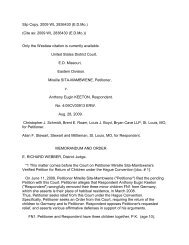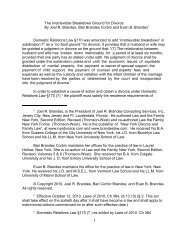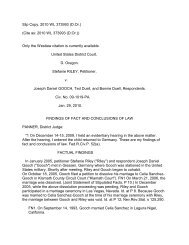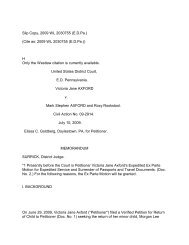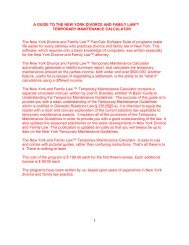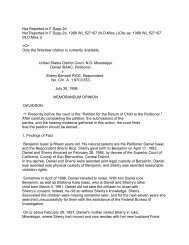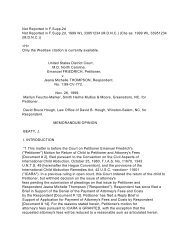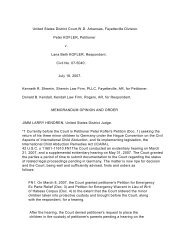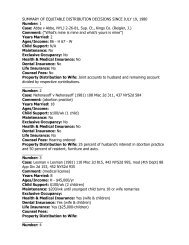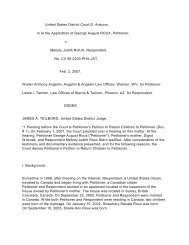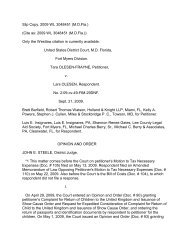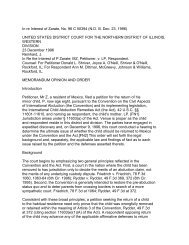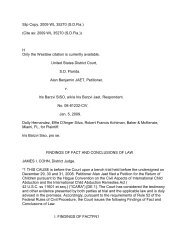Etienne v. Zuniga
Etienne v. Zuniga
Etienne v. Zuniga
Create successful ePaper yourself
Turn your PDF publications into a flip-book with our unique Google optimized e-Paper software.
children were not returning to Mexico. <strong>Etienne</strong> testified on cross-examination that when<br />
the children were not back in Mexico to start school in January he knew something was<br />
wrong.<br />
Tr. 159-60. In January of 2009 <strong>Etienne</strong> was no longer having regular telephone contact<br />
with E.N. and B.N. and the children were still enrolled in school in Washington. Tr.129;<br />
257-58. <strong>Etienne</strong>'s own testimony indicates that he may have had knowledge as early as<br />
July of 2008 that Villarreal did not plan on returning to Mexico. Tr. 178-79 (<strong>Etienne</strong><br />
testifying that Villarreal called him from the airport and told him that she was going to<br />
give the children a better life than he could give them); see Exhs. 7 & 8 (<strong>Etienne</strong>'s<br />
signed applications under the Convention for the return of the children in which he<br />
wrote<br />
July 4, 2008, as the date of wrongful removal or retention); see also Tr. 157-58<br />
(confirming the date written in the applications). Taking into account all of the evidence<br />
presented at trial, the Court concludes that <strong>Etienne</strong>'s petition was filed outside the oneyear<br />
period following the wrongful retention of the children.<br />
(ii) Are the Children Well Settled in the United States?<br />
Because the Court has concluded that <strong>Etienne</strong> did not file his petition within one year<br />
of the wrongful retention of the children, Villarreal is entitled to demonstrate that the<br />
children should not be returned because they are now settled in their new environment.<br />
See Convention, art. 12. The Convention itself does not define what constitutes a child<br />
being "settled in its new environment." Id.<br />
However, the U.S. State Department has established that "nothing less than substantial<br />
evidence of the child's significant connections to the new country is intended to suffice<br />
to meet the respondent's burden of proof" in asserting the well-settled defense. Public<br />
Notice 957, Text & Legal Analysis of Hague International Child Abduction Convention,<br />
51 Fed.Reg. 10494, 10509 (U.S. State Dep't Mar. 26, 1986). Accordingly, the mere<br />
passage of time does not establish this defense. Anderson, 250 F.Supp.2d at 880<br />
(citing In re Robinson, 983 F.Supp.<br />
1339, 1345 (D.Colo.1997)). "Rather, the evidence must show that the child is 'in fact<br />
settled in or connected to the new environment so that, at least inferentially, return<br />
would be disruptive with likely harmful effects.' "<br />
Anderson, 250 F.Supp.2d at 880-81 (quoting In re Robinson, 983 F.Supp. at 1345).<br />
Courts analyzing this defense have weighed several factors in determining whether a<br />
child is "settled" for purposes of this defense. In re B. DEL C.S.B., 559 F.3d 999, 1009<br />
(9th Cir.2009); In re Koc, 181 F.Supp.2d 136 (S.D.N.Y.2001); In re Robinson, 983<br />
F.Supp. at 1346; Zuker, 2 F.Supp.2d at 141. In In re B. DEL C.S.B., the Ninth Circuit<br />
adopted a list of six factors it considered relevant to a court's determination of whether<br />
a child is now settled in a new environment:<br />
*11 (1) the child's age; (2) the stability and duration of the child's residence in the new<br />
environment; (3) whether the child attends school or day care consistently; (4) whether<br />
the child has friends and relatives in the new area;<br />
(5) the child's participation in community or extracurricular school activities, such as<br />
team sports, youth groups, or school clubs; and (6) the respondent's employment and



